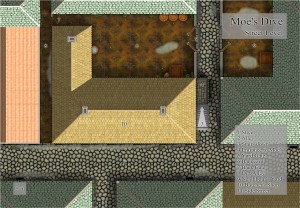 The November Annual issue was released on Tuesday, providing a detailed floorplan and street map of Moe’s Dive, a generic seedy bar to use in your adventures. It also contains a combined City Designer 3/Dungeon Designer 3 template for those close-up street battle maps.
The November Annual issue was released on Tuesday, providing a detailed floorplan and street map of Moe’s Dive, a generic seedy bar to use in your adventures. It also contains a combined City Designer 3/Dungeon Designer 3 template for those close-up street battle maps.
Inspired by the Geomorphic dungeons of Dave’s Mapper and the idea of vertical dungeon maps by Stonewerk on his blog, I created a set of geomorphic dungeon tiles for the August Annual complete with the style and tools to draw your own.
EDIT: The style was inspired by the images posted on the ProFantasy Community Forum, which I mistakenly thought came from Stonewerk’s Blog. The proper source is Dyson Logos’s blog “A Character for Every Game“. Sorry for the mistake and thanks for the great inspiration!
Here is my complete example map for Issue 56 of the Cartographer’s Annual (click image for a larger view):

We’ve just released the June issue of the Cartographer’s Annual 2011, and we’re very happy to present another style created by map-making artist Jon Roberts.
This time we went for a dungeon/floorplan style and the result is really gorgeous again. Take a look at these beautiful maps: Continue reading »
More Dungeon Symbols
The February issue of the Annual 2011 is now available. It provides a huge selection of dungeon and battlemap symbols for use in DD3. The number of individual symbols comes to a staggering 1500 – making the download larger than most of our full products. Community member Joachim de Ravenbel created the objects in Pov-ray and exported their top-down view as high-resolution bitmaps. We took those, created CC3 symbols from them and sorted them into catalogs for easy in use in CC3/DD3.

The October issue of the Annual 2010 was released on Friday, and we are very happy to publish the awesome new commands created by community member Joachim de Ravenbel for CC3. They make it extremely quick and easy to draw complex wall layouts, as you would see in an actual medieval castle, including doorways, alcoves, windows and arrow slits.
It is also a great example what users can contribute directly to CC3. If you are interested in programming your own commands for CC3, check out Lee Saunders’ CC3 development blog and the CC developers’ mailing list.
